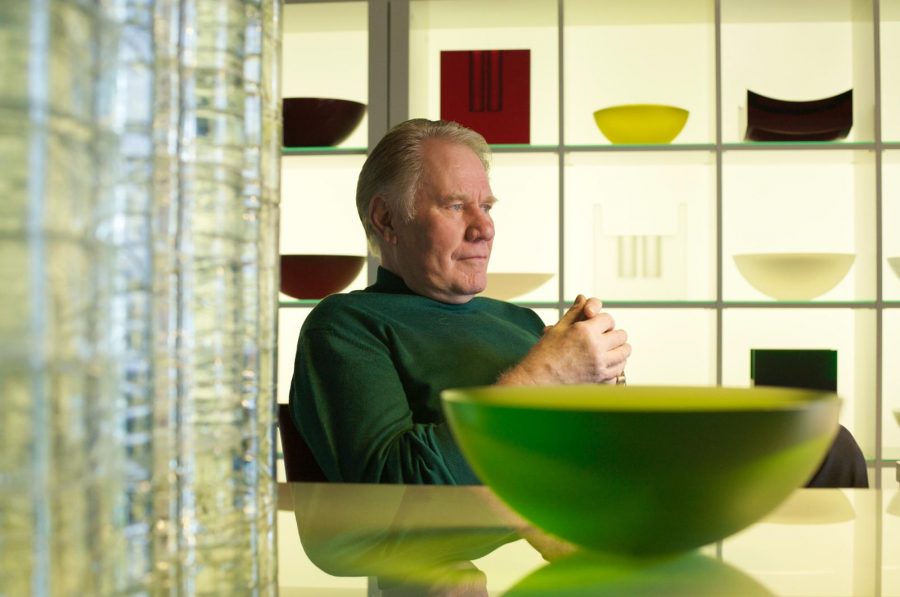
Frantisek Vizner was the great minimalist in Czech glass art. While still a student he perfected a technique and a sense of form that has sustained him throughout a distinguished career of some fifty years.
His training was lengthy and rigorous, first at the Specialized Schools of Glassmaking in Nový Bor and Železný Brod, followed by six years of study at the Academy of Applied Arts in Prague under Professor Karel Štipl. Frantisek Vizner emerged from this with a group of glass vessels in his graduation year of 1962 that set a course for his future. He was among that early cohort of students newly emerging at a time when glass was especially promoted as an art-material as well as a utilitarian one, then vital to the country’s economy and identity. For Vizner, the vessel was to be more than sufficient as a vehicle for personal expression. His graduation work explored smoothly rounded cubes and rectangles and even in this, his earliest work, it is clear that he was thinking about making a related set of forms, in which each vase had its own character but all came together to form a whole concept. This group is still seen as a key moment in post-war Czech modernism, the philosophical and stylistic movement that grew from a functionalism rooted in avant-garde design of the 1930s. Then practical, restrained and elegant shapes became part of the lexicon and, in the hands of Frantisek Vizner, they were again a potent force in the 1960s.
His first employment was in designing for a demanding and competitive commercial industry at Škrdlovice glassworks and other factories to make inexpensive glasswares for machine production. Since his natural inclination was for unembellished shapes and precise technical requirements, he was perfectly suited to produce designs for useful wares that could be made by the blown glass method in which the Škrdlovice glassworks specialised. It was the next step towards a lifetime’s dedication to the exploration of minimalist form. For Vízner the transformation of ‘the bowl’ into an ‘art object’ was inexorable. Nevertheless, he always said that utilitarian objects are the key to his work. He quoted the basket and the jug as familiar articles in any simple home, perhaps the first we learn about along with the cup, bowl or plate. An ‘art object’ may be the result, but its origin in these humble, essential forms, is always apparent in his glass.
Vízner set up his own studio in 1977. By then he was well-respected and becoming an important figure internationally. His first exhibition abroad was in Paris, followed by galleries in Zurich, Essen, Vienna and, in 1988, in New York. Since then he had exhibited world-wide and his glass is in all the major public collections. He created large scale sculpture too, such as the major wall installation in the Karlovo námĕstí underground station in Prague in 1981.
Probably his best known form is the bowl with a single, central peak. First made in 1971 this classic had been a life-long preoccupation. Variations on it were the result of careful consideration and the introduction of new colours. Vízner was never precipitate and each new form carries the same message of very precise thinking and intellectual restraint. There were never any ill-judged moves. Technique was vital too, and a deep understanding of the material. Transforming a solid glass block into the springy, light-transforming object that is, typically, Vízner’s small sculpture, had been one of his special skills. He cut, drilled and worked the glass into the sensuous, rhythmic contours that had become his trademark. The surface was then acid-etched to a matt finish. While his contemporaries in Czechoslovakia specialised in precision-cut, geometric, prismatic glass or in blown glass, freely formed and sometimes painted, sculptures, Frantisek Vizner steadfastly stayed with the vessel. He had been briskly unappreciative of what he regarded as the further reaches of excessive artistic expression especially in the early 1980s. Then he said ‘The vase always was and still remains my positive destiny in glass…Artistic fantasy is given as an excuse for everything. The vase presents a frightening and at the same time beautiful limitation of functions. I like handicraft and I like beautiful objects’. To the rest of his career, this credo underpinned Vízner’s commitment to pure form.
Uniquely, he had achieved, repeatedly, a finely undulating landscape over which flows a silky, matt surface. Thus he blended a highly sensitive manipulation of light and delicate colour with perfectly sculpted forms. Transparency in its usual manifestations held no interest for him. But the glowing edges and the body of his glass have an intense, interior light, a life unmatched by any other artist. A work by Vízner is truly unmistakeable.
Vizner’s extraordinary objects, with their clean, articulated lines and deep, luminous colours, continue to impress collectors around the world and are represented in the most prominent museum collections: Museum of Applied Art and Craft in Prague, The Metropolitan Museum of Art in New York, Victoria and Albert Museum in London, Musée des Arts décoratifs in Paris, The Corning Museum of Glass and many others.
For information on more available work from this artist, please contact us.